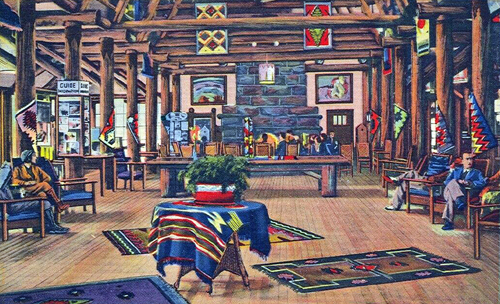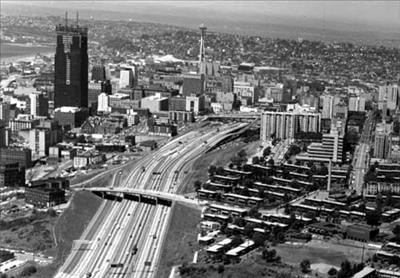

8482 HistoryLink.org articles now available.
Diablo Dam incline railway climbing Sourdough Mountain, 1930. Courtesy Seattle Municipal Archives, 2306.
Children waving to ferry, 1950. Courtesy Museum of History and Industry.
Loggers in the Northwest woods. Courtesy Washington State Digital Archives.

5/8/2025

Historic Preservation
May is Historic Preservation Month, and this week HistoryLink looks at some of Washington's National Historic Landmarks. We begin with the state's first NHL, Chinook Point – where Captain Robert Gray first saw the Columbia River – which was designated in 1961 along with American and English Camps on San Juan Island. In 1964 the Marmes Rockshelter was named a landmark, but it has since been submerged due to the construction of Lower Monumental Dam.
Buildings that are national landmarks include Seattle's Panama Hotel, the Georgetown Steam Plant, Paradise Inn (shown above) at Mount Rainier National Park, the B Reactor at Hanford, and the Fort Nisqually Granary, which now sits at Point Defiance. Structural groupings include Fort Worden, Port Gamble, Port Townsend, the Bonneville Dam Historic District, and Seattle's Pioneer Building, Pergola and Totem Pole in Pioneer Square.
Washington maritime history is represented by the Puget Sound Naval Shipyard, which was designated in 1992. Vessels on the landmark list include the Virginia V, the lightship Swiftsure, and the fireboat Duwamish. In all, Washington has 24 sites designated as National Historic Landmarks as well as 1,597 buildings, structures, objects, sites, and districts on the National Register of Historic Places. We're very proud of that.
Springtime Ambulation
A good way to celebrate Historic Preservation Month is by taking our walking tours at HistoryLink.tours. These highly illustrated tours are self-guided, easily accessible via public transportation, and offer a fascinating glimpse into the history of some of your favorite neighborhoods, parks, and other places around Puget Sound. And we're always adding more.
Of course, you can visit them in any order you like, but a good place to start on a warm sunny day is Volunteer Park, an Olmsted-designed, landmark park located on Seattle's Capitol Hill. Or visit the Central District, the city's oldest surviving residential area. Make your way down First Hill, head over to the Chinatown-International District, and then stop by the historic Pioneer Square neighborhood to learn about the history of its music scene, its LGBTQ+ community, and its public art. Farther north, explore Belltown, then enjoy an architectural tour of Pike Place Market, which is also the home of our HistoryLink office. Wander the central waterfront, then walk from the market to MOHAI.
Don't miss our other walking tours of Tacoma’s Union Station/Warehouse Historic District, Everett's Forest Park, Everett Riverside, downtown Snohomish, Kenmore, Issaquah, South Lake Union, and Pike Place Market eateries. Now go out there and enjoy, you might even learn something new!
Roslyn was founded in 1886 after surveyors from the Northern Pacific Railway found rich seams of coal nearby. But mining the coal came with a price. On May 10, 1892, in the worst coalmine disaster in Washington history, 45 men lost their lives in an explosion and fire at the Roslyn mine.
A pair of Washington's long-standing buildings celebrates birthdays this week. On May 9, 1893, the New Whatcom City Hall opened in Bellingham and is now home to the Whatcom Museum of History and Art. And Seattle's King Street Station opened on May 10, 1906, and is currently served by Amtrak trains and Sounder commuter rail.
On May 12, 1915, the Jefferson Park Golf Course opened on Seattle's Beacon Hill, making it the city's first municipally owned greens. Designed by Scotsman Thomas Bendelow – the "Johnny Appleseed of American golf" – the course became a favorite for all local golfers, including members of the African American, Japanese American, and Chinese American communities.

Interstate 5 was completed in Washington on May 14, 1969.
"It has been said that, at its best, preservation engages the past in a conversation with the present over a mutual concern for the future."
—William Murtagh